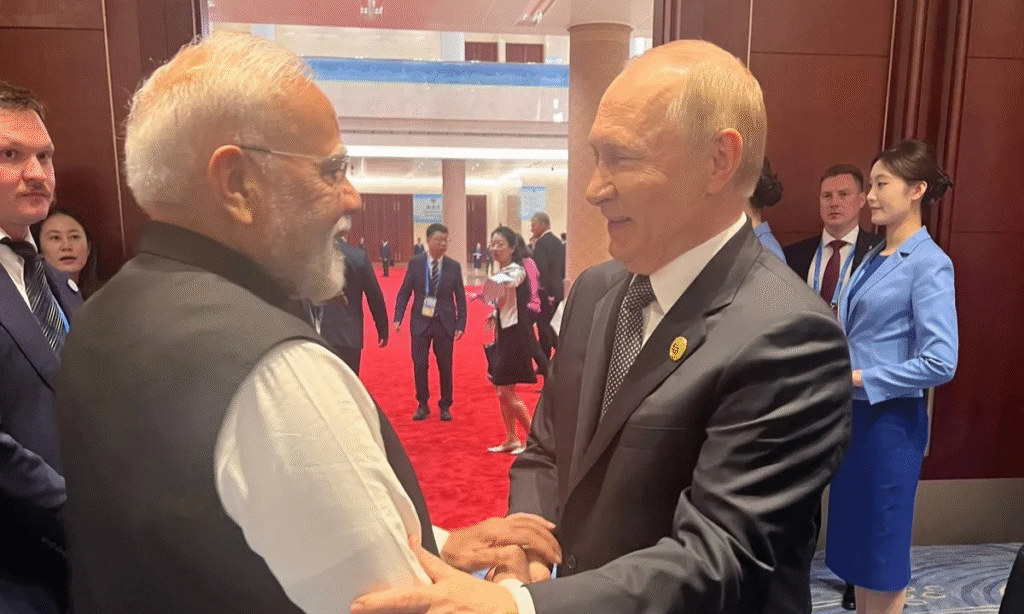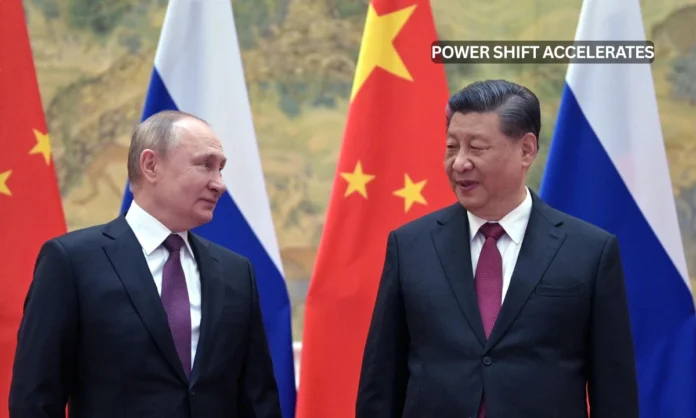Key Highlights:
- European defense spending reached record €343 billion in 2024, projected to hit €381 billion in 2025, exceeding NATO’s 2% GDP target for first time
- China-Russia-India summit demonstrates emerging coalition challenging Western-led international order while Europe adapts security strategies
- Finland and Sweden’s NATO membership fundamentally reshapes Northern European security architecture amid deteriorating strategic environment
Opening Context: Europe’s Strategic Awakening
The recent China-hosted summit featuring Russian President Vladimir Putin alongside leaders from India, Iran, and North Korea marks a pivotal moment in global power dynamics, forcing European Security Transformation to accelerate at an unprecedented pace. This gathering of authoritarian and non-aligned leaders, punctuated by military displays and diplomatic messaging, signals a coordinated challenge to Western dominance that European security planners can no longer ignore.
The continent’s defense strategies have become an urgent necessity as traditional assumptions about Western hegemony crumble. The events in Beijing, where Putin stood shoulder-to-shoulder with Xi Jinping, Narendra Modi, and Kim Jong Un, demonstrated that despite Western sanctions and isolation efforts, Russia maintains powerful allies capable of sustaining its military operations. This reality compels Europe beyond conventional NATO frameworks toward more autonomous defense capabilities.

The implications extend far beyond Ukraine’s borders. European Security Transformation must now account for a multipolar world where China’s economic might, India’s strategic pragmatism, and Russia’s military aggression combine to challenge the post-Cold War order that has underpinned European stability for three decades.
Europe’s Defense Spending Revolution: Quantifying the Security Shift
The continent’s defense evolution is most visible in expenditure patterns that reflect awakening to new strategic realities. The European Defense Agency‘s 2024-2025 data reveals unprecedented spending levels that underscore how seriously European nations take emerging threats.
Record-Breaking Investment Surge
European Union member states collectively allocated €343 billion to defense in 2024, representing a staggering 19% increase from the previous year. This security evolution through financial commitment will continue in 2025, with projected spending reaching €381 billion, bringing the bloc’s defense expenditure to 2.1% of GDP for the first time since data collection began.

European Defense Spending and GDP Percentage (2014-2025) showing the trajectory of European security transformation
The scale of this European Security Transformation becomes clearer when comparing current spending to recent history. Defense expenditures hit their lowest point in 2014 at just €189 billion, coinciding with Russia’s initial annexation of Crimea. Since then, continental security evolution has driven spending increases for ten consecutive years, with the most dramatic acceleration following Russia’s full-scale invasion of Ukraine in February 2022.
Strategic Investment Priorities
The continent’s security evolution emphasizes capability development over personnel expansion. Defense investment accounted for 31% of total spending in 2024, reaching €106 billion and crossing the €100 billion threshold for the first time. Equipment procurement dominated this surge, growing 39% year-over-year to €88 billion, while research and development increased 20% to €13 billion.
This strategic approach reflects a quality-over-quantity methodology. Total defense expenditure per active military personnel reached €249,000 in 2024, up from €138,000 in 2014, indicating that European Security Transformation prioritizes advanced capabilities rather than larger armies. However, this approach creates potential personnel shortages for operating and maintaining sophisticated new equipment systems.
Nordic Integration: Finland and Sweden Reshape Security Architecture
The most dramatic example of continental defense evolution involves Finland and Sweden’s NATO accession, fundamentally altering Northern European strategic calculations. These traditionally neutral nations abandoned decades of non-alignment policies in response to Russia’s aggression, completing their security transition journey in record time.
Strategic Geographic Advantages
Finland and Sweden’s NATO membership represents a quantum leap in defensive effectiveness. Finland’s 1,340-kilometer border with Russia doubles NATO’s direct frontier with Russian territory, while Sweden’s strategic position controls access to the Baltic Sea, creating what military analysts describe as a “Baltic Lake” scenario favorable to Western forces.
This European Security Transformation significantly enhances collective defense capabilities in the Nordic region. Finland already meets NATO’s 2% GDP defense spending target, while Sweden has committed to achieving this benchmark by 2026, demonstrating their serious commitment to contributing meaningfully to continental security efforts.
Operational Integration Challenges
Despite rapid political integration, the security evolution faces technical hurdles in incorporating Finnish and Swedish capabilities. Both nations operate different equipment standards and command structures than existing NATO members, requiring extensive interoperability programs to maximize their strategic contribution to regional defense systems.
The success of Nordic integration will likely determine whether other neutral European nations consider similar strategic realignments. Switzerland and Austria remain officially neutral, but growing security pressures may eventually force them to reconsider their positions as European Security Transformation accelerates across the continent.
China-Russia-India Coalition: Strategic Implications for European Security
The Shanghai Cooperation Organization summit revealed the extent to which continental defense planning must address not just Russian threats but a broader coalition of powers challenging Western influence. This gathering demonstrated how security evolution occurs within a multipolar context where traditional allies may not always align with European interests.
Economic Pragmatism vs. Security Concerns
China and India’s approach to supporting Russia illustrates the complexity facing European defense planners. Both nations maintain official neutrality regarding Ukraine while simultaneously providing economic lifelines that sustain Russia’s military operations. China and India became the world’s largest buyers of Russian oil and coal, with China also purchasing significant quantities of Russian gas products.
This economic support system complicates continental security strategies. Despite Western sanctions, Russia accesses critical dual-use technologies through Chinese and Indian companies, including components for drones targeting Ukrainian infrastructure. European Security Transformation must therefore account for indirect military support flowing through seemingly neutral trading relationships.
European Security Transformation Strategic Partnership Limitations
However, continental defense planning benefits from inherent tensions within the China-Russia-India coalition. These relationships remain transactional rather than ideological, based on temporary convergent interests rather than shared values. Iran learned these limitations when Russia failed to support it during Israeli and American attacks, while Putin didn’t intervene when Assad’s Syrian regime collapsed despite being a mutual ally.
North Korea’s participation represents the most transactional relationship, providing manpower for Russian operations while gaining economic benefits and diplomatic protection. This arrangement highlights how European defense systems must prepare for conflicts involving multiple authoritarian states coordinating military and economic support networks.

NATO’s Evolving Strategic Framework: From 2% to 5% GDP Targets
Continental security evolution operates within evolving NATO frameworks that demand increasingly substantial financial commitments. The alliance’s new guidelines require member states to allocate higher percentages of GDP to defense-related spending, representing a dramatic escalation from previous targets.
European Security Transformation Escalating Defense Spending Requirements
NATO defense spending surged to record levels in 2025, with total alliance expenditure reaching $1.6 trillion. This European Security Transformation mandate reflects growing recognition that current spending levels remain insufficient to address emerging threats. Poland already approaches 4% of GDP allocation, followed by Estonia, Latvia, and Lithuania, all exceeding 3% GDP allocation.
Achieving enhanced security targets would require EU member states to increase defense spending substantially above current projections. The new framework recognizes that continental defense evolution requires sustained investment over extended periods rather than temporary spending surges.
European Security Transformation Infrastructure and Innovation Focus
The comprehensive approach to security evolution reflects lessons learned from Russia’s hybrid warfare tactics, including cyber attacks, disinformation campaigns, and critical infrastructure targeting. Continental defense systems must therefore integrate civilian and military preparedness to create resilient societies capable of withstanding multidomain threats.
This holistic view of security architecture acknowledges that modern challenges extend beyond traditional military domains to encompass cybersecurity, economic resilience, and social cohesion. Success requires coordinated efforts across multiple government agencies and private sector partnerships.
Final Assessment: Europe’s Security Independence Journey
European Security Transformation represents a fundamental shift from post-Cold War assumptions about permanent Western dominance toward recognition of multipolar strategic competition. The convergence of authoritarian powers demonstrated at the China summit, combined with potential American strategic pivot toward domestic priorities, compels European nations to develop more autonomous security capabilities.
The unprecedented defense spending increases, Nordic NATO expansion, and evolving alliance frameworks indicate that continental security evolution has moved beyond reactive measures toward proactive strategic planning. However, success requires sustained political commitment, enhanced industrial cooperation, and continued transatlantic partnership despite changing American priorities.
Security modernization faces the challenge of building sufficient capabilities to deter multiple potential adversaries while maintaining economic prosperity and democratic governance. The next decade will determine whether European nations can successfully navigate this transformation to secure their strategic autonomy in an increasingly contested international environment.


